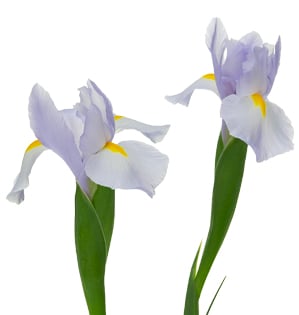Iris

Common Names: Iris, Fleur-de-Lis, Flag
Botanical names: Iris, (EYE-ris)
Availability: Year round
Vase life: 3 to 7 days
Storage temperatures: 36 - 38 degrees Fahrenheit
Ethylene Sensitive: No
Description: Distinctively shaped blossom of three inner petals and three outer petals with three sepals between them opening widely from a spear shaped bud and sword like foliage.
Color: White, purple, yellow, and blue
Botanical facts: Named after the Greek goddess of the rainbow. In Greek mythology, Iris was a messenger from the gods who traveled to earth on a rainbow. Wherever she stepped, flowers sprang up.
Design notes: Excellent line flower. Used frequently in contemporary and Asian styled design. Can be used for emphasis and accent. Allow plenty of space around blossoms so they may open fully.
Purchasing hints: Purchase flowers in the bud stage which are just beginning to show color. Foliage should be medium green with no yellowing or brown tips. If the tip of the flower is dried or curled, the blossom will not open.
Conditioning: Remove all foliage that will be below the water line. Cut stem ends with a sharp knife. Hydrate in a solution of water and commercial floral food for two hours before storage or usage.
Additional notes: The opening of the buds can be "hurried" by carefully peeling back the sheath from the bud, then gently tapping the stem against your hand. This will pop the flower head open. In Greek mythology, Iris is the messenger of the gods. Cloaked in a robe of dewdrops reflecting the stars, Iris communicates messages via the rainbow, considered the bridge between heaven and earth. The iris is the symbol of Idea and Message and the name itself means "rainbow." In some languages, irises are called flags or sword flags, relating them to symbols of heraldry and royalty. In Japan the shape is seen to express heroism and the blue color refers to blue blood, so irises play a key role in their spring festival for boys. The popularity of irises over the centuries has been demonstrated in the still life paintings of the Dutch masters and more recently has inspired Vincent van Gogh.
Video Demonstration:

